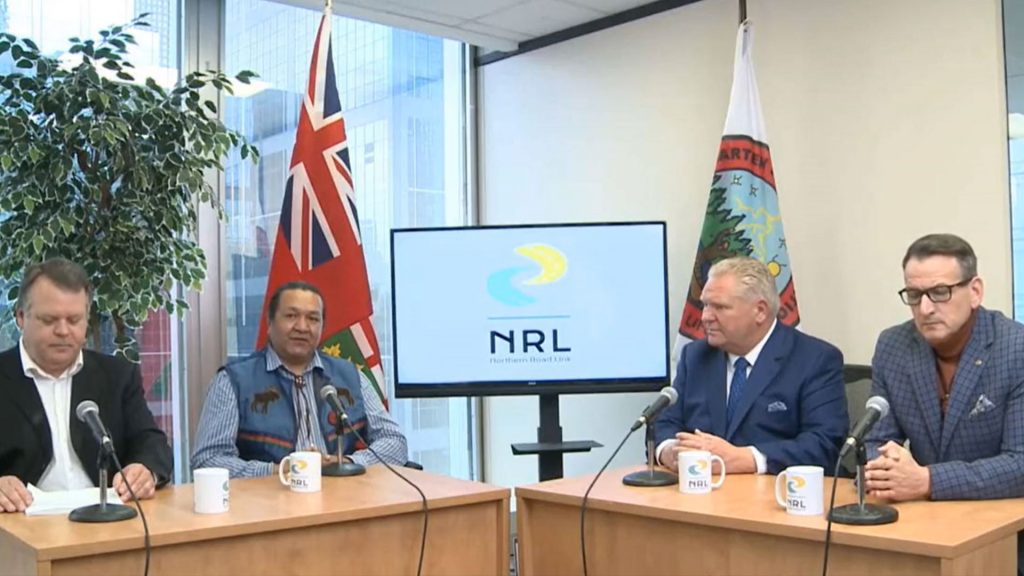
Officials announcing two Ontario First Nations are moving with an environmental assessment for the Ring of Fire road project. On centre left is Chief Bruce Achneepineskum of Marten Falls First Nation. Photo: Facebook
Two First Nations in Ontario will be going forward with an environmental assessment in the provinces’ Ring of Fire region, which officials say is a “historic” move for unlocking jobs and economic opportunities.
“It’s something we’re very proud of and want to move forward on in a good way,” Chief Bruce Achneepineskum of Marten Falls First Nation said at a press conference on Thursday.
The same day Achneepineskum, Chief Cornelius Wabasse of Webequie First Nation, Premier Doug Ford and Greg Rickford, Minister of Northern Development, Mines, Natural Resources and Forestry announced the two First Nations would be submitting terms of reference for the proposed Northern Road Link Environmental Assessment.
Terms of reference, which is essentially a plan for how parties will collaborate, will be a defining piece in the proposed construction of the road which would link potential mining sites to the region.
According to the province, the Ring of Fire, located on Treaty 9 territory, 500 km northeast of Thunder Bay, spans 5,000 km and is one of the most promising mineral development opportunities for critical minerals in Ontario.
Around two years ago Achneepineskum and Wabasse proposed to build roads linking their fly-in communities with the Ring of Fire. The proposed project would connect both First Nations communities to Ontario’s highway network and create substantial employment opportunities.
Achneepineskum said that the project is now coming to fruition.
“This is a move forward for us in terms of economic reconciliation alleviating the conditions in the community, the poverty levels that we have faced in the decades past,” he said.
Marten Falls and Webequie will co-lead the planning of the road project, while Ontario has committed close to $1 billion to support critical legacy infrastructures such as the planning and construction of an all‑season road network, and investments in high-speed internet, road upgrades and other community support.
Officials say mining in the region would help push the province to be a leading producer of critical minerals needed to power electric vehicles and promote a clean economy.
“Our government is connecting industries, resources and workers in the north to the auto and EV battery manufacturers in the south so we can unlock the full economic potential of northern Ontario,” Ford said in a press release.
Read More:
First Nations ‘merely pawns’ in wrangling over Ring of Fire: Marten Falls chief
Chiefs say feds taking ‘harmful and dishonorable’ course on Ring of Fire environmental assessment
‘Pawns in the scheme’
The announcement follows mounting pushback from First Nations surrounding the Ring of Fire who want more say in mineral development of the region.
In a Jan.19 letter to Environment Minister Guilbeault, five chiefs in the Ring of Fire region described the area as “the world’s lungs” due to its ability to absorb carbon dioxide, and that rampant mining would “release its huge store of carbon and escalate climate change further into catastrophe.” The letter also called on Guilbeault to scrap the proposed deal.
The chiefs also expressed concern that the draft terms of reference were narrow, tokenistic, exacerbated the climate crisis and overstepped Indigenous sovereignty.
Kashechewan Chief Gaius Wesley said on Nation to Nation that the draft needed to be “thrown out.”
“They need to work with the First Nations people through a co-led and co-enforced approach to ensure that the people in our region also have their say,” he said.
Last month Achneepineskum, whose community of Marten Falls is closest to the Ring of Fire, also expressed his concern on Nation to Nation.
“The government makes the law. They make the policy, and First Nations are merely, right now, pawns in that scheme,” he said.
With agreed-upon terms of reference in hand, Achneepineskum says now “there’s a lot of work still to do.”
“We’re going to be moving on to the actual work of the environmental assessment. Moving forward with the actual studies that are going to be happening.”
With files from Brett Forester










